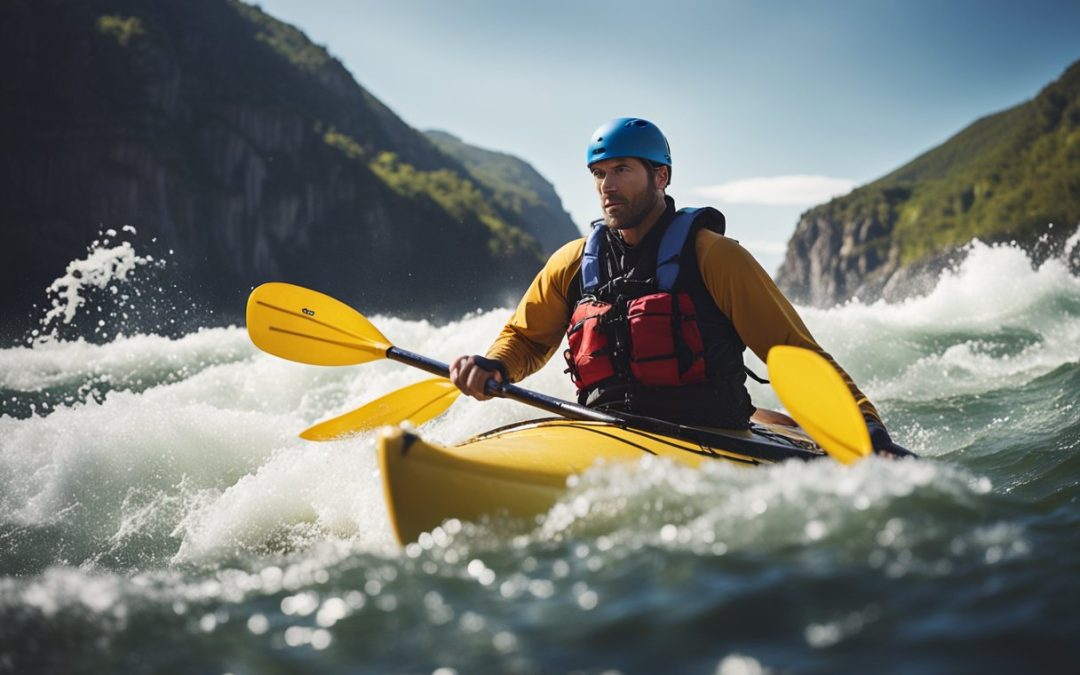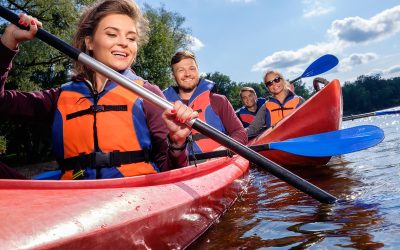Eco-Friendly Lifevest, Sustainable Life Vest: The Ultimate Guide for Conscious Swimmers
Eco-friendly life vests are becoming increasingly popular as both manufacturers and consumers recognize the importance of sustainability in the world of water sports. These vests are designed with the same focus on safety as traditional life vests, but with an emphasis on using sustainable materials and minimizing environmental impact. The market for sustainable life vests has expanded considerably in recent years, as more companies recognize the benefits of these environmentally responsible products and more consumers seek to make eco-conscious choices.

Understanding the features and benefits of eco-friendly life vests is essential for anyone looking to make a responsible and informed purchase. Sustainable life vests are crafted using materials that are either recycled, certified organic, or produced using low-impact processes. The products also prioritize functionality and performance, ensuring that they are as effective and reliable as their less sustainable counterparts. As the market for eco-friendly life vests continues to grow, consumers have a wide range of options to choose from, including vests from well-known brands and innovative startups committed to sustainability.
Key Takeaways
- Eco-friendly life vests prioritize sustainability and safety.
- Materials used include recycled, organic, and low-impact fabrics.
- A variety of options are available from both established and emerging brands.
Understanding Eco-Friendly Life Vests

What Makes a Life Vest Eco-Friendly
An eco-friendly life vest is one that is made from sustainable and environmentally friendly materials like natural fibers, recycled cotton, recycled poly, and other low impact resources. The design and manufacturing process also emphasize minimizing waste, upcycling, and efficient use of resources. For example, some life vests may utilize recycled polyester from used plastic bottles or repurpose discarded materials, reducing their ecological impact.
It’s essential that these materials meet safety standards without causing harm to the environment. This often involves using organic cotton or organic fabric in the production of life vests to reduce the reliance on harmful agricultural practices, pesticides, and synthetic chemicals. Moreover, eco-friendly life vests often feature low-impact dyes and minimal chemical usage during manufacturing.
Here are some key elements found in eco-friendly life vests:
- Sustainable and natural materials
- Recycled poly, cotton, and polyester
- Organic cotton or fabric
- Upcycling and recycling practices
The Impact of Sustainable Life Vests on the Environment
The use of sustainable life vests has a notable positive impact on the environment. By choosing vests made of recycled polyester or other eco-friendly materials, consumers can help reduce waste and limit the depletion of natural resources. Additionally, the production of sustainable materials generally consumes less water, energy, and other resources compared to conventional production processes.
When it comes to the disposal of eco-friendly life vests, upcycling and recycling practices play a crucial role in minimizing environmental impact. As these vests can often be repurposed or recycled at the end of their lifespan, they help to reduce landfill waste, decrease harmful emissions, and promote a circular economy where materials are continuously reused.
To sum up, sustainable life vests contribute to a healthier environment by:
- Reducing textile waste
- Limiting depletion of natural resources
- Decreasing water and energy consumption
- Encouraging upcycling and recycling practices
Materials and Fabrics

Organic and Recycled Materials in Life Vests
Life vests made from organic and recycled materials such as GOTS certified organic cotton, recycled polyester, and recycled wool are becoming more prevalent in the market. These materials not only promote sustainability but also reduce waste and carbon emissions during the production process. For instance, recycled polyester could be derived from recycled plastic bottles, reducing the amount of plastic waste in the environment.
Another option is recycled poly or PET (polyethylene terephthalate), which is made from recycled plastics and can be turned into resilient fabric suitable for life vests. The use of these recycled materials reduces the carbon footprint associated with the production of new synthetic fabrics.
Innovative Fabrics: Tencel, Hemp, and Econyl
In addition to recycled materials, there are innovative sustainable fabrics that can be used for eco-friendly life vests:
-
Tencel: This soft and breathable material is derived from the wood pulp of eucalyptus trees, which require less water and energy to grow compared to traditional cotton. Tencel’s production process is environmentally friendly because it uses a closed-loop system that recovers and reuses solvents and water. It is also biodegradable, offering an eco-conscious choice for your life vest.
-
Hemp: Known for its strength and durability, hemp is a fast-growing plant that requires minimal water and chemicals during cultivation. Hemp fabric is highly absorbent and naturally resistant to UV rays, making it an ideal option for life vests. Moreover, hemp has a high carbon sequestration capacity, contributing to the effort of reducing CO2 in the atmosphere.
-
Econyl: This innovative fabric is made of regenerated nylon recovered from waste materials like fishing nets and carpets. Econyl is not only eco-friendly but also offers excellent durability, breathability, and resistance to water absorption, which makes it suitable for life vests.
When selecting a sustainable life vest, it is essential to consider the material composition and opt for products made from organic, recycled, or innovative fabrics like Tencel, hemp, and Econyl. By doing so, you are not only ensuring your safety on the water but also contributing to the preservation of our planet.
Design and Functionality

Layering and Versatility of Sustainable Vests
Sustainable life vests come in a variety of styles and materials, offering numerous options for layering and versatility. Fleece vests, for instance, are ideal for insulation beneath a waterproof outer layer. They provide warmth without bulk, maintaining comfort and mobility during outdoor activities. In contrast, sweater vests can be worn standalone or over a shirt for a polished yet eco-conscious look.
Eco-friendly life vests also utilize materials that offer improved performance without compromising on environmental responsibility. For example, the Trail Vest by Houdini employs wind-resistant, highly breathable, and recyclable fabric to withstand various conditions while remaining lightweight.
Functional Aspects of Ethical Life Vests
When it comes to design, ethical life vests strive to combine form with function. They feature adjustable straps for a customizable fit, like the Superlite USCG Life Vest. This particular life vest is designed to fit most body types and is made with USCG-approved Type III nylon for safety and durability. In addition, it weighs in at just 2 pounds to ensure maximum comfort.
Some eco-friendly life vests are also designed for specific water activities. For instance, the Ronix Wakeboard Vest is meant to cater to wakeboarders and wake foilers, boasting added flexibility. Extra features may also be present to improve usability, such as pockets and attachment points for accessories.
In conclusion, sustainable life vests offer an attractive alternative for those seeking eco-friendly, practical, and versatile outerwear options. With their smart design, ethical materials sourcing, and various uses, these life vests cater to both the functional and environmental needs of their wearers.
Brands and Market Leaders

Cotopaxi and Eileen Fisher: Pioneers in Ethical Fashion
Cotopaxi is a well-known brand in the ethical fashion scene, specializing in outdoor gear and apparel. Their sustainable vests are made from recycled materials, and they are committed to responsible manufacturing and supply chain practices. Cotopaxi’s vests provide warmth and comfort without compromising on environmental protection. Check out their collection here.
Eileen Fisher is another pioneer in ethical fashion, with a focus on timeless and sustainable designs. The brand is known for its use of eco-friendly materials and fair labor practices. Eileen Fisher offers a selection of sustainable vests that are both stylish and responsible. Browse their range of products here.
Emerging Sustainable Vest Brands
In addition to established market leaders, there are up-and-coming brands specializing in sustainable vests. One such brand is Armedangels, a German company that prides itself on offering fair and sustainable clothing options. Their collection includes eco-friendly vests made from organic cotton and other sustainable materials.
Another noteworthy brand is Houdini, which offers ethical vests designed for high-intensity activities. These sustainable vests are wind-resistant, highly breathable, and even recyclable, ensuring that they have minimal impact on the environment.
With companies like Cotopaxi, Eileen Fisher, Armedangels, and Houdini, consumers now have a variety of ethical and sustainable vests to choose from. These brands are setting a new standard for the fashion industry by offering stylish and environmentally friendly options, paving the way for even more sustainable brands in the future.
Consumer Guide

How to Choose an Eco-Friendly Life Vest
When selecting an eco-friendly life vest, consider the following factors to ensure you’re making a sustainable and responsible choice.
- Materials: Look for life vests made from recycled or sustainably sourced materials. These offer a lower environmental impact compared to traditional petroleum-based materials.
- Non-toxic: Opt for life vests that use non-toxic dyes and are free from harmful chemicals such as PVC, BPA, and phthalates.
- Fair Trade: Support brands that ensure fair trade practices, benefiting workers involved in producing the vests.
- Durability: A well-constructed, durable life vest will last longer, reducing the need for frequent replacements and minimizing waste.
- Affordability: While eco-friendly life vests might be more expensive than traditional vests, they’re an investment in the environment and may save you money in the long run due to their durability.
Care and Maintenance of Sustainable Vests
Taking proper care of your sustainable life vest is crucial for maintaining its performance and extending its lifespan. Consider the following tips for effective care and maintenance:
- Cleaning: Clean your life vest after each use by rinsing it with fresh water to remove salt, sand, and any debris. Avoid using harsh chemicals, as they may damage the materials. Use a gentle, eco-friendly detergent if necessary, and allow the vest to air-dry completely before storing.
- Storage: Store your life vest in a cool, dry place away from direct sunlight to prevent damage from UV rays and heat. Do not compress the life vest, as this may cause the foam to lose buoyancy over time.
- Inspection: Regularly inspect the vest for damage, wear, and tear. Look for signs of fraying, loose straps, or weakened foam. Replace the life vest if it no longer meets safety standards or if its buoyancy has been compromised.
- Proper Use: Always wear the life vest as directed by the manufacturer. Using the life vest in unintended ways or as makeshift flotation could cause damage and compromise its performance.
By following these guidelines, you can ensure that your eco-friendly life vest stays in top condition, performs well, and continues to protect you for years to come.
Lifestyle Integration

Incorporating Eco-Friendly Vests into a Capsule Wardrobe
A capsule wardrobe refers to a collection of essential clothing items that can be easily mixed and matched to create various outfits. In this context, adding an eco-friendly life vest to your capsule wardrobe provides a sustainable and versatile option. By selecting a life vest made from sustainable materials such as tencel lyocell or merino wool, you can effortlessly incorporate it into your wardrobe without sacrificing style or functionality.
Some key pieces that work well with eco-friendly vests include:
- Linen shirts: Lightweight and breathable, linen is the perfect complement for layering with a life vest.
- Merino wool sweaters: Warm and moisture-wicking, merino wool is an ideal material for colder climates.
- Tencel lyocell pants: Known for being soft and comforting, tencel lyocell pants provide a stylish yet sustainable option.
Sustainable Fashion for Different Climates
Moving into different climates and seasons provides the opportunity to explore various eco-friendly materials and styles in your life vest choices. For example, when dressing for fall, layering is key. Pairing a merino wool life vest with a linen shirt offers functionality and breathability while adding an understated touch to your outfit.
However, warmer climates require a different approach when wearing eco-friendly life vests. Linen is an excellent lightweight and breathable fabric that can help keep you cool. For maximum versatility, consider pairing a linen life vest with a checkerboard patterned item to add visual interest to your ensemble.
Here are some climate-adaptable life vest options:
| Climate | Material | Example |
|---|---|---|
| Warmer Climates | Linen | Linen Life Vest |
| Cooler Climates | Merino Wool | Merino Wool Life Vest |
By consciously selecting sustainable life vest materials such as merino wool or linen and focusing on versatile options, you can seamlessly integrate eco-friendly life vests within your capsule wardrobe. By doing so, you contribute to a more sustainable fashion industry and promote environmental consciousness in your daily attire.
Global Influence

Sustainable Vest Trends in London and Los Angeles
In both London and Los Angeles, sustainable fashion is experiencing a rise in popularity. Consumers are becoming more aware of the environmental impact of their clothing choices and are seeking alternatives to fast fashion. One of the dominating trends in these cities is the emergence of eco-friendly life vests. These vests are produced from sustainable materials and processes, ensuring minimal harm to the environment while providing the necessary safety features.
Another prevalent trend in these cities is the growing popularity of vintage and secondhand clothing. Many eco-conscious consumers are opting for pre-loved clothing items, as it plays a vital role in reducing waste and promoting a circular economy. Life vests that have been upcycled or repurposed are particularly attractive to such consumers.
Sweden’s Approach to Sustainable Living
Sweden has long been known for its commitment to sustainable living and eco-friendly initiatives. One Swedish brand, Houdini, has developed a trail vest that is not only ultra-light and suitable for high-intensity activities, but also wind-resistant, highly breathable, and even recyclable. This innovative approach to life vests demonstrates Sweden’s dedication to sustainable innovation while maintaining safety and functionality.
In summary, the global influence of sustainable life vests is evident in the growing trends seen in London, Los Angeles and Sweden. With an emphasis on eco-friendly materials, upcycling and innovative design, the sustainable life vest industry is poised to make a positive impact on the environment while meeting consumer demand for responsible fashion.
Ethical Considerations
Ethically Made Vests and Their Significance
In recent years, consumers have become increasingly aware of the environmental and social impacts of the products they purchase. This has led to a growing demand for ethically made products, including life vests. Ethically made life vests typically prioritize the use of sustainable materials and responsible manufacturing practices. For example, upcycled materials, such as regenerated nylon or deadstock fabric, are often utilized in the production of these vests. In addition, many companies now manufacture life vests using post-consumer plastic bottles to help reduce waste and environmental impact.
The significance of ethically made life vests extends beyond reducing environmental harm. By choosing an ethically made vest, consumers are contributing toward a sustainable economy and promoting fair labor practices. Companies that follow ethical guidelines typically ensure their workers are treated fairly and paid a living wage. This is particularly important in the apparel industry, which has historically faced a myriad of labor issues.
The Intersection of Fair Trade and Life Vest Production
One approach to ensuring ethical practices in the production of life vests is through fair trade certification. Fair trade certified companies must adhere to strict standards, including fair labor practices, environmental sustainability, and transparent supply chains.
Some eco-friendly life vest brands are making strides in incorporating fair trade principles into their operations. For instance, Patagonia is a certified B Corporation that uses recycled and sustainable materials, and is part of the 1% for the planet organization. They offer a range of jacket styles, which can be an inspiration for life vest producers to follow similar ethical practices.
Furthermore, smaller eco-conscious brands, such as Tentree, are also committed to ethical production and sourcing methods. By supporting companies that provide ethically made and fair trade life vests, consumers can help drive change in the industry and promote sustainable practices.
In conclusion, the ethical considerations of eco-friendly life vests encompass both the materials used and the fair treatment of workers. By selecting ethically made and fair trade certified products, consumers can make a positive impact on the environment and society as a whole.
Frequently Asked Questions
What materials are used in the construction of sustainable life vests?
Eco-friendly life vests are typically made with materials that have a low environmental impact, such as recycled plastics or natural fibers like kapok, a plant-based flotation material. Some manufacturers also use biodegradable or organic-based foams that reduce the use of synthetic materials.
How does the buoyancy of eco-friendly life vests compare to traditional options?
The buoyancy of sustainable life vests is generally comparable to that of traditional options. Whichever flotation material is used, the key is to ensure the life vest meets the required buoyancy standards and safety certifications. Always check the label on the life vest to verify the vest’s rated buoyancy.
What certifications should I look for in sustainable life jackets to ensure safety?
To ensure safety, look for life jackets with certifications from recognized organizations such as the United States Coast Guard (USCG), European Union (CE/ISO), or the International Maritime Organization (IMO). These certifications ensure that the life jacket has been tested and meets established safety standards.
How do I properly maintain and care for an eco-friendly life vest?
Maintaining and caring for an eco-friendly life vest involves similar steps to those for traditional life vests. After use, rinse the vest with fresh water and allow it to dry completely, avoiding direct sunlight. Store the life vest in a dry, cool location away from UV light. Periodically inspect the vest for signs of wear or damage and replace when necessary.
In terms of durability, how do eco-friendly life vests stand up to frequent use?
Eco-friendly life vests can offer similar durability to traditional life vests as long as they are made from high-quality materials and have been properly cared for. Like all life vests, sustainable options require regular inspections for wear and tear, and should be replaced if signs of damage are apparent.
Are there specific brands that specialize in eco-friendly life jackets suitable for water sports?
Yes, there are brands that specialize in eco-friendly life jackets for water sports, such as Astral, Stohlquist, and NRS. These brands offer sustainable life vests designed for various activities like kayaking, paddleboarding, and sailing. When selecting an eco-friendly life vest, consider the specific requirements and recommendations for the intended water sport.
Conclusion
In recent years, there has been a growing awareness of the need for eco-friendly products to preserve our environment. One such product is the sustainable life vest. These life vests minimize their environmental impact by using materials that are biodegradable or recycled and by adopting sustainable manufacturing processes.
The use of eco-friendly materials has several advantages:
- Biodegradable materials such as natural fibers (e.g., hemp and organic cotton) can reduce dependency on petroleum-based synthetic materials and decompose more quickly, reducing waste in landfills.
- Recycled materials (e.g., polyester made from recycled plastic bottles) help conserve resources and reduce plastic pollution in our oceans.
Several well-established manufacturers and innovative startups have recognized the demand for sustainable life vests and are now offering them as part of their product lineup. When choosing an eco-friendly life vest, consider the following factors:
- Material: Look for life vests that use biodegradable or recycled materials in their construction.
- Certifications: Make sure the life vest has appropriate safety certifications and is compliant with international standards.
- Manufacturing processes: Research the company’s manufacturing practices to ensure they prioritize sustainability and minimize their environmental footprint.
In conclusion, investing in a sustainable life vest is not only an ethical choice but also a practical one. By doing so, consumers can enjoy their water activities knowing they are contributing to the preservation of our environment for future generations.









